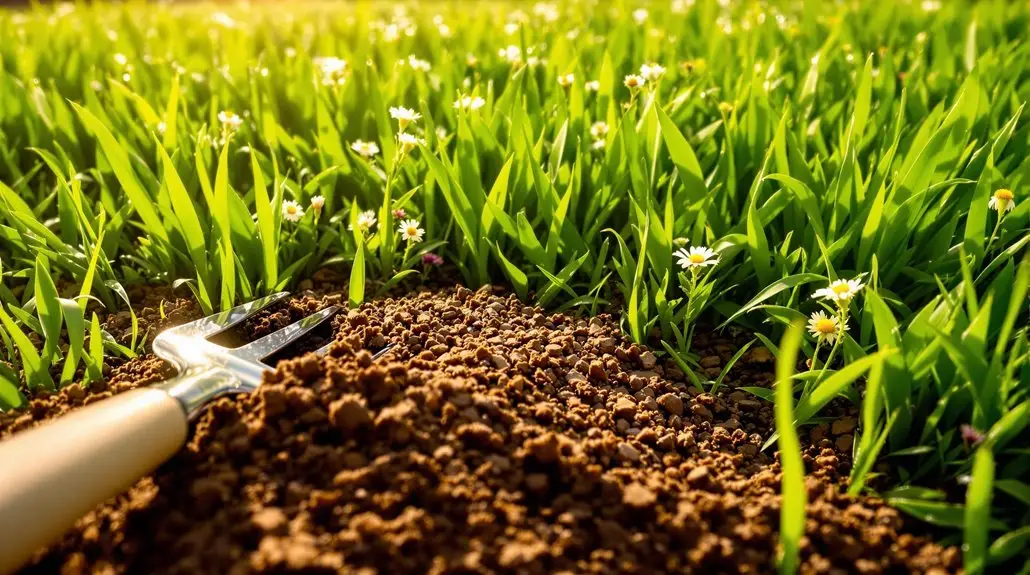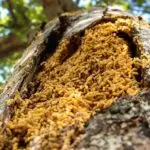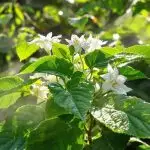To keep your St. Augustine lawn thriving in South Florida, focus on enhancing soil health and using organic fertilizers. Start with a soil test to maintain a pH between 6.0 and 7.0. Regularly apply compost and compost tea to boost nutrients, and aerate yearly for better water and nutrient uptake. Water deeply and less frequently, targeting 1 inch per week, especially during the hot months. Monitor for pests and apply biological treatments for protection. By implementing these practices, you’ll cultivate a lush lawn. Stick around to uncover additional insights that can transform your lawn care routine!
Key Insights
- Conduct soil tests to ensure pH levels are between 6.0 – 7.0 for optimal St. Augustine grass health.
- Regularly apply organic matter like compost to enhance soil fertility and microbial activity.
- Implement deep watering techniques, ensuring 6-8 inches of moisture weekly for strong root growth.
- Mow St. Augustine grass at a height of 2.5-4 inches, changing directions to prevent wear.
- Use compost tea and biological fungicides to boost soil health and protect against diseases naturally.
Soil Preparation Techniques
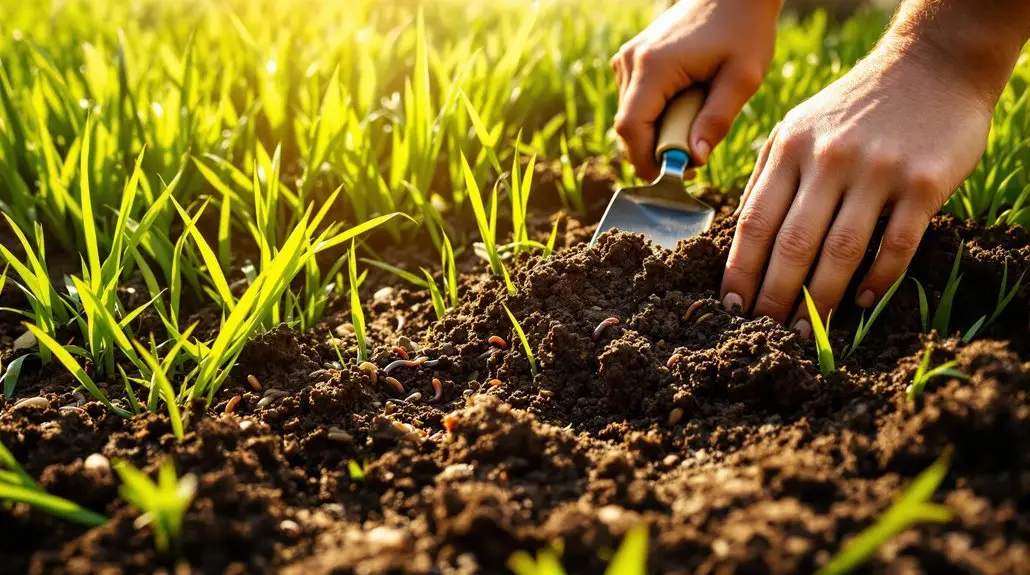
Preparing the soil is an essential step for nurturing a thriving St. Augustine lawn. You want to start by conducting soil tests to determine your soil’s pH levels, nutrient content, and structure. You can use DIY soil testing kits or send samples to a lab for detailed analysis. Ideally, your soil’s pH should be between 6.0 and 7.0, so keep an eye on that.
Be certain to analyze nutrient levels, focusing on nitrogen, phosphorus, and potassium, as these are significant for healthy grass growth.
Once you’ve gathered your soil data, it’s time to enhance its fertility and structure with organic matter. Adding compost is a great starting point, and well-rotted manure or green manure can also work wonders.
Try incorporating peat moss or coconut coir to help retain moisture, and don’t forget about organic mulch to reduce erosion and maintain heat. Aim to apply a 2-3 inch layer of this organic matter and till it into your soil for the best results.
Aeration is another important technique. Aerate your lawn at least once a year to improve air, water, and nutrient circulation. Whether you use a manual or mechanical aerator, it’ll help reduce soil compaction.
Additionally, guarantee proper drainage to prevent waterlogging, which can harm your St. Augustine grass. By taking these steps, you’ll create an ideal environment for your lawn to flourish and thrive.
Organic Fertilization Methods
When it comes to organic fertilization for your St. Augustine lawn, compost tea can provide a nutrient boost while enhancing soil health. You’ll also want to contemplate slow-release fertilizer options, which deliver nutrients steadily over time, reducing the risk of over-fertilization. Additionally, consider incorporating holistic lawn care practices to further support your lawn’s health and resilience. Let’s explore how these methods can help your lawn thrive.
Compost Tea Benefits
Compost tea offers a powerful boost to your St. Augustine lawn, enhancing soil health and promoting a vibrant ecosystem. By introducing beneficial bacteria, fungi, and other microbes, it replenishes those depleted by chemical use and supports a balanced soil environment. This not only aids in early spring greening but also helps reduce thatch, improves soil structure, and enhances your lawn’s ability to store water and drain properly. Additionally, compost tea enhances soil structure by creating air pockets that promote root health.
When you apply compost tea, you’re not just nourishing your grass; you’re also fortifying it against pests and diseases. A healthy lawn can resist drought, heat, and cold, reducing your reliance on chemical insecticides. Plus, by fostering beneficial microbes, you create a balanced ecosystem that minimizes pest issues. Regular application of compost tea can also improve your lawn’s resilience against pest infestations common in South Florida.
For best results, apply compost tea during the spring and fall when your lawn’s root system is most active. Dilute it with water to prevent any burning, and consider using a sprayer or irrigation system for even coverage. Brew it for 24-36 hours to maximize microbial growth, and aim to use it every two weeks.
This sustainable practice not only saves you money but also helps you connect with nature while creating a thriving community of healthy lawns.
Slow-Release Fertilizer Options
Finding the right slow-release fertilizer can make all the difference for your St. Augustine lawn. Consider Down to Earth Organic Bio-Turf 8-3-5. It’s OMRI-listed and packed with natural ingredients like feather, meat, and bone meal, promoting healthy root growth and enhancing overall resilience. This option works wonders in spring, helping roots absorb more nutrients and water.
Another fantastic choice is Espoma Organic All-Season Lawn Food. Its natural formula is free from sludges and fillers, ensuring security for kids and pets while delivering dense growth and vibrant color. Plus, it contains bio-tone microbes that boost soil health for the long haul, contributing to optimal lawn health.
Don’t overlook Safer Brand Lawn Restore Natural Fertilizer. This blend nourishes your grass without synthetic chemicals, allowing it to flourish thick and lush. It’s also secure for your loved ones and features a slow-release formula to prevent nutrient burn.
Remember to measure your lawn accurately and use the right spreader type for even application. Water thoroughly post-application to lock in those nutrients.
With these organic slow-release options, you’ll nurture a thriving St. Augustine lawn that you and your family can enjoy.
Effective Weed Control
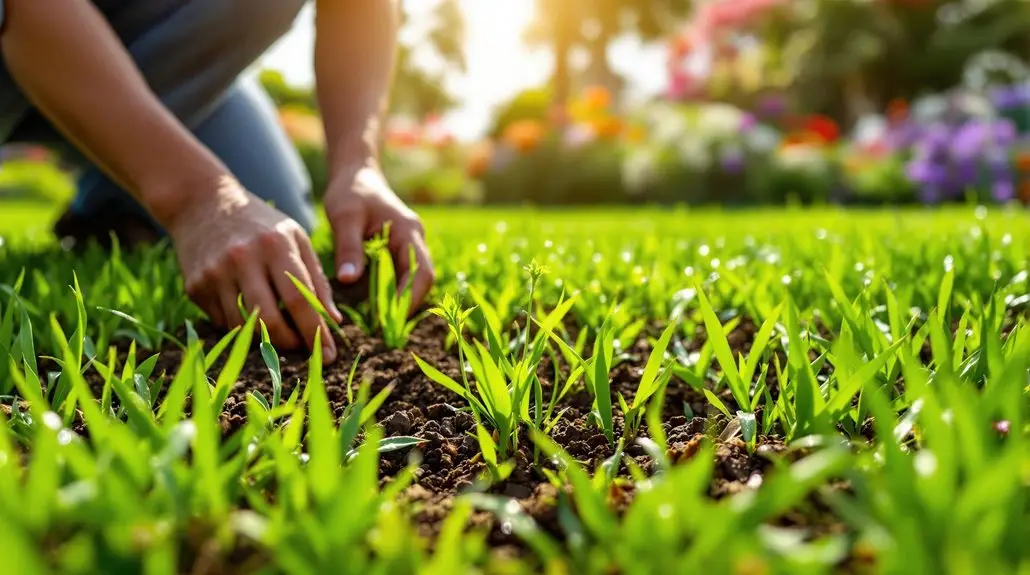
To maintain a lush and healthy St. Augustine lawn, effective weed control is crucial. A dense turf not only beautifies your yard but also helps prevent weed establishment. By implementing integrated turf management practices like proper mowing, irrigation, and fertilization, you’ll create an environment that discourages weeds. Optimal control of weeds can be achieved under adequate soil moisture. Additionally, a well-maintained lawn can also deter pests like roaches that are common in Florida.
Here’s a quick guide to help you tackle weed control effectively:
| Strategy | Description |
|---|---|
| Mowing | Keep mower blades sharp and avoid mowing in winter to reduce stress on grass. |
| Irrigation | Water regularly, especially during dry spells, to keep turf healthy. |
| Herbicide Application | Apply herbicides to young, actively growing weeds, ensuring you select products secure for St. Augustinegrass. |
Don’t forget about the importance of preventing weed seed dispersal. Always wash your mowers and trimmers after using them in weed-infested areas, and make sure to clean rototillers thoroughly. Properly disposing of yard clippings containing weeds is essential too.
Cultural practices like planting grass plugs closely together can also minimize the chance for weeds to intrude. By keeping a dense turf, you’ll shade the soil, making it harder for weeds to grow.
Natural Pest Management
Natural pest management is essential for keeping your St. Augustine lawn healthy and thriving in South Florida. By using Integrated Pest Management (IPM), you can tackle pest issues effectively.
Start by conducting thorough inspections to identify specific pests like chinch bugs and sod webworms. Once you know what you’re dealing with, develop targeted treatments that utilize eco-friendly methods to minimize impact on your landscape and local wildlife. Regular monitoring and ongoing communication are key; check your lawn often to catch pest problems early and adjust your treatment plans as needed. Additionally, maintain your lawn’s health through proper mowing, irrigation, and fertilization to help prevent pest issues from arising in the first place. Effective pest control is achieved through safety-first approaches that prioritize environmental health.
Consider organic and natural alternatives, too. Adding a thin layer of high-quality compost can greatly improve soil health, making your grass less susceptible to diseases. Encourage beneficial insects that naturally control pest populations, and use biological fungicides like Bacillus subtilis to protect against pathogens.
For specific pests, such as fire ants and whiteflies, employ targeted bait treatments and eco-friendly insecticides. Frequent monitoring will also help you stay ahead of pink hibiscus mealybugs.
Water Conservation Strategies
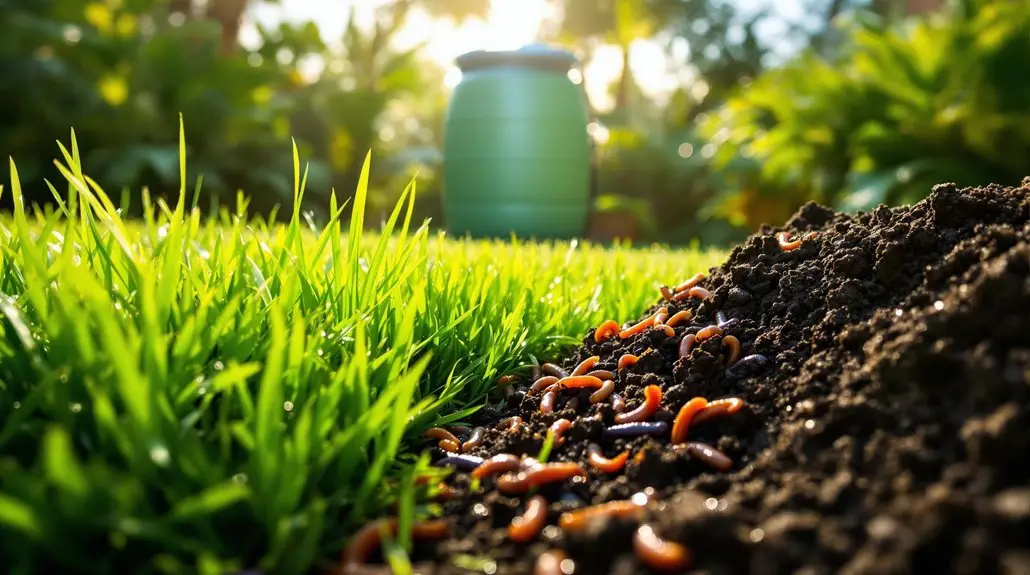
To keep your St. Augustine lawn healthy while conserving water, focus on deep watering techniques that promote strong root growth. Consider installing a rainwater harvesting system to collect and utilize natural rainfall, reducing your reliance on municipal water. Additionally, adopting efficient irrigation methods can help you apply just the right amount of water without waste. Implementing deep watering encourages healthier root systems and enhances drought tolerance.
Deep Watering Techniques
When it comes to deep watering techniques for St. Augustine lawns, you’ll want to focus on promoting a robust root system while conserving water. Water your lawn once or twice a week during the growing season, adjusting based on seasonal changes. It’s essential to guarantee water penetrates 6 to 8 inches deep, applying about 1 inch weekly. Here’s a quick reference table to guide you:
| Watering Aspect | Recommendation | Notes |
|---|---|---|
| Watering Frequency | 1-2 times a week | Adjust for weather; less in wet seasons |
| Ideal Watering Time | 4 a.m. – 10 a.m. | Minimize evaporation; reduce fungal risks |
| Depth of Watering | 6-8 inches | Promotes healthy root systems |
| Amount of Water | ~1 inch per week | Adjust for soil type; avoid runoff |
| Soil Type Consideration | ½ – ¾ inch for sandy soils | Prevent excessive infiltration |
Keep an eye on your lawn for signs of drought, like folded blades or a bluish-grey hue. Additionally, understanding the seasonal changes in South Florida will help you adjust your watering schedule effectively. By following these techniques, you’ll not only maintain a healthy lawn but also foster a sense of community with fellow lawn enthusiasts working toward the same goal.
Rainwater Harvesting Systems
Implementing a rainwater harvesting system can be a game-changer for your St. Augustine lawn. By collecting and storing rainwater, you not only conserve water but also provide your plants with the natural hydration they crave.
Here are a few key steps to get you started:
- Determine your water usage: Estimate how much water you need for your lawn by reviewing historical bills or using an average of 1-1.5 inches of water per week.
- Assess collection potential: Calculate how much rainwater you can capture based on your roof size. For instance, 1 inch of rain on a 1,000 sq. ft. roof yields over 620 gallons! Additionally, consider that efficient gutter systems can enhance your tank filling capabilities.
- Choose the right tank size: Make sure your storage tank can meet your irrigation demands, considering variations in rainfall.
Don’t forget to install gutters and downspouts to direct rainwater efficiently to your tank.
Consider using first flush diverters to maintain water quality by filtering out debris.
With proper planning and maintenance, your rainwater harvesting system won’t only reduce your water bills but also promote a healthier, thriving lawn.
Join the movement, and let’s make sustainable choices together!
Efficient Irrigation Methods
Efficient irrigation methods are vital for maintaining a healthy St. Augustine lawn in South Florida. By mastering your irrigation strategy, you not only conserve water but also guarantee your lawn thrives. Water your grass 2-3 times a week, adjusting based on the heat index, especially during the summer months. Always follow local watering restrictions. Proper irrigation management helps in developing a thick, strong, green turf that can effectively combat pests and weeds. Additionally, incorporating eco-friendly practices into your lawn care routine can enhance overall plant health.
| Irrigation Aspects | Recommended Practices | Notes |
|---|---|---|
| Frequency | 2-3 times/week | Adjust for heat and seasons |
| Duration | 30 min (spray zones) | 45-60 min (rotor zones) |
| Best Timing | 1:00 AM – 3:00 AM | Prevents evaporation |
| Maintenance | Check sprinkler heads | Confirm they’re not clogged |
| Zone Customization | Divide yard into zones | Tailor water needs |
Timing is essential; early morning is best to minimize evaporation. Avoid watering during the day, and make certain your lawn dries before nightfall to prevent disease. Regularly check your system and consider drip irrigation for plant beds to boost efficiency. By embracing these practices, you’re not just caring for your lawn, but also contributing to a community that values sustainability.
Mowing Best Practices
Mowing your St. Augustine lawn is essential for maintaining its health and beauty. To get the best results, keep these best practices in mind:
- Mowing Height: Aim for 2.5-4 inches depending on your grass type. Dwarf varieties thrive at 2.5-3 inches, while standard ones prefer 3-4 inches. Always adjust the height for shade or drought conditions.
- Mowing Frequency: Mow when your grass grows to one-third above your desired height. During summer, aim for weekly mowing, but ease off to every 2-3 weeks in the dormant season. More moisture means more frequent cuts!
- Mowing Techniques: Never cut more than one-third of the grass blade at a time. Change your mowing direction each time to prevent wear and reduce grain. Sharp blades are key, so keep them well-maintained. Additionally, be aware that St. Augustinegrass has a moderate shade tolerance which allows it to thrive in less than full sun.
After mowing, leave the grass clippings on the lawn; they act like free fertilizer and help with nitrogen absorption. If clumping occurs, you can redistribute them by lightly raking or remowing.
Don’t forget to water your lawn after mowing to keep the roots hydrated.
Aeration Importance
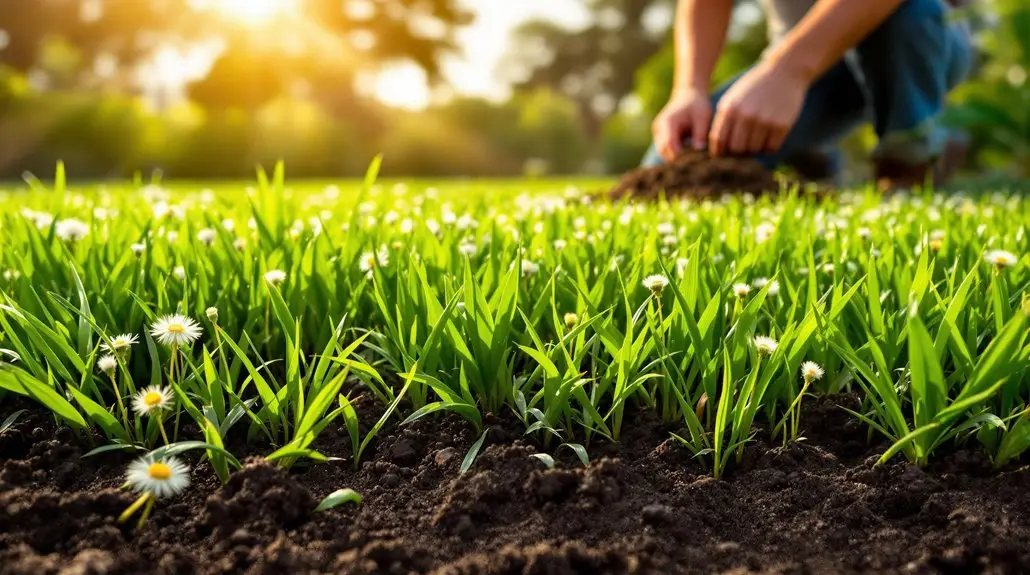
Aeration plays an essential role in maintaining a healthy St. Augustine lawn. It helps alleviate soil compaction, allowing your grass to access water and nutrients more effectively. When you aerate, you’re promoting healthier root growth by letting air, moisture, and vital nutrients reach the roots. This process is fundamental for keeping your lawn vibrant and thriving.
One of the key benefits of aeration is its impact on the thatch layer. By breaking up this layer, you prevent it from becoming too thick and suffocating your lawn. Additionally, after aeration, your lawn becomes more efficient at absorbing fertilizers, ensuring that your grass gets the nutrients it needs to flourish. This process supports overall lawn health and resilience during growth phases.
It also improves water absorption, which means you won’t have to water as frequently, saving you time and resources.
The best time to aerate your St. Augustine grass is towards the end of spring, when the grass is actively growing. Aim to aerate at least once a year, but if you have high-traffic areas or poor soil quality, consider doing it more often. Using a core aerator is the most effective method, as it pulls up soil plugs that help with both thatch decomposition and root health.
After aeration, remember to fertilize and water your lawn adequately to support recovery. By incorporating aeration into your lawn care routine, you’ll foster a lush, healthy environment that you and your neighbors can take pride in.
Mulching Benefits
When it comes to maintaining a thriving St. Augustine lawn, mulching is one of your best allies. Not only does it enhance the beauty of your landscape, but it also offers numerous practical benefits that every homeowner should appreciate.
Here’s why you should consider incorporating mulch into your lawn care routine:
- Soil Temperature and Moisture Management: Mulch acts as a protective layer, keeping your soil warm in winter and cool in summer. It considerably reduces moisture evaporation, guaranteeing your grass roots stay hydrated, especially during dry spells.
- Weed Control and Aesthetic Benefits: A layer of mulch inhibits weed germination, keeping your lawn looking neat and uniform. Plus, it enhances your landscape’s visual appeal with its rich colors and textures.
- Soil Health and Fertility: As mulch decomposes, it enriches the soil with organic materials, improving aeration, drainage, and fertility. This means healthier plants and reduced soil erosion.
To get the most out of mulching, apply it in a 2- to 3-inch layer around established plants while avoiding piling it against tree bases to prevent rot.
Regularly raking out old mulch ensures proper water and air penetration, keeping your lawn in top shape.
Seasonal Lawn Care Tips
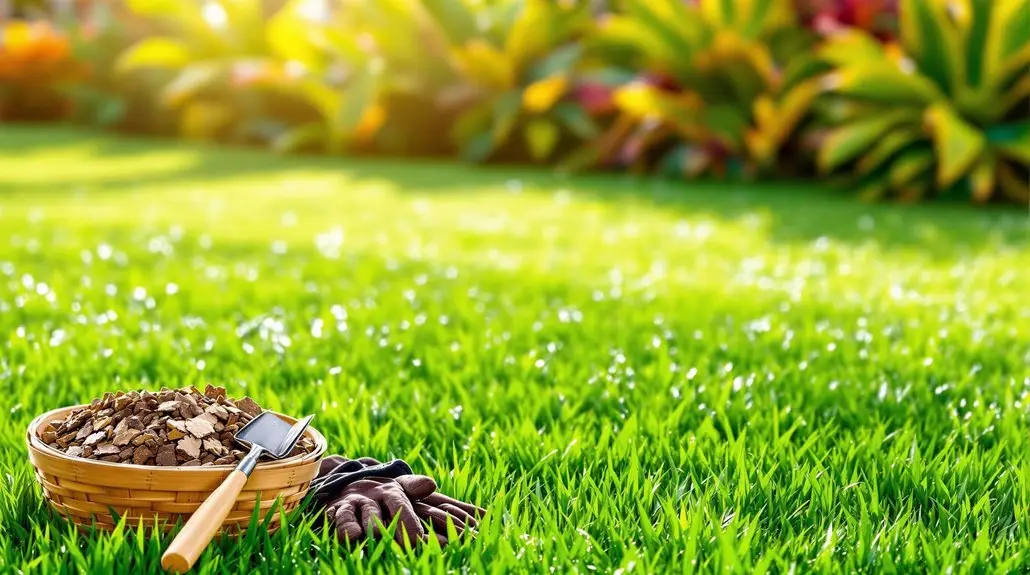
To keep your St. Augustine lawn thriving throughout the year, it’s important to adjust your care routine with the seasons. Here’s a quick guide to help you stay on track:
| Season | Key Tips |
|---|---|
| Spring | – Water 2-3 times a week – Mow regularly and leave clippings – Apply pre-emergent crabgrass control |
| Summer | – Water 2-4 times a week – Maintain mowing height at 3-4 inches – Focus on pest and weed control |
| Fall | – Water 1-2 times a week – Apply autumn-blend fertilizer – Dethatch if necessary |
In spring, as your lawn awakens, start watering it two to three times a week. Mow when the grass is active, letting the clippings enrich the soil. Don’t forget to apply a weed and feed fertilizer and check for pests.
During the summer, your watering needs will increase to two to four times a week. Keep the mowing height consistent, and focus more on controlling pests and weeds rather than fertilizing.
As fall approaches, cut back on watering and apply an autumn-blend fertilizer to support your grass’s health. If you notice thatch buildup, it’s time to dethatch and aerate.
Enhancing Soil Health
To enhance the health of your St. Augustine lawn, start by testing your soil pH to identify any nutrient imbalances.
Adding organic matter can markedly improve soil structure and nutrient retention, while aeration techniques help promote deeper root growth.
Soil Ph Testing
Understanding soil pH is essential for maintaining a healthy St. Augustine lawn. The ideal pH range for your grass is between 6.0 and 7.0, with 6.5 to 7.0 being particularly favorable. If your soil’s pH strays outside this range, you might face issues like fungal diseases or nutrient deficiencies.
Regular soil testing is key to identifying the pH and nutrient levels in your lawn.
Here are some factors to keep in mind:
- Highly alkaline soils may need sulfur or sphagnum peat moss to lower pH.
- Acidic soils often require dolomitic limestone to raise the pH gradually.
- Soil pH influences nutrient availability and microbial activity, vital for a thriving lawn.
Conducting a soil test will empower you to make informed decisions about amendments and fertilizers. Local UF/IFAS Extension offices can provide the necessary instructions and materials for taking soil samples.
By understanding and adjusting your soil pH, you can create a robust foundation for your St. Augustine grass to flourish and enhance your lawn’s overall health.
Organic Matter Addition
Adding organic matter to your St. Augustine lawn is vital for enhancing soil health and promoting lush growth. By incorporating materials like compost, Canadian sphagnum, or chicken litter, you’re creating a nutrient-rich environment that fosters strong roots and vibrant grass.
Humic acid plays an important role in improving nutrient uptake and water retention, making certain your lawn gets what it needs.
When you add organic matter, you’re not just feeding your grass; you’re also supporting the beneficial microbes that make your soil alive and thriving. This microbiome enhances moisture retention, so you won’t have to water as frequently.
Plus, a well-structured soil helps in breaking down thatch, allowing your roots to breathe and grow deeper.
For the best results, apply organic matter monthly, especially during the active growing season. Mixing it into the top few inches of soil guarantees even distribution, maximizing its benefits.
Aeration Techniques
Aeration techniques are essential for maintaining a healthy St. Augustine lawn. By aerating your lawn, you’re enhancing soil health and promoting vigorous growth. The best time to aerate is mid-spring through early summer, ensuring your grass has the ideal conditions to thrive. You can choose from various aeration methods, depending on your lawn’s needs.
Here are some effective techniques to take into account:
- Core aeration: Removes plugs of soil, allowing air, water, and nutrients to penetrate deeply.
- Spike aeration: Punctures the soil without removing cores, but it’s less effective than core aeration.
- Liquid aeration: Useful for sandy soils, it breaks up compacted areas with a liquid solution.
Aeration helps reduce soil compaction, promotes stronger root systems, and enhances water penetration.
After aerating, be sure to fertilize and water your lawn thoroughly to boost nutrient absorption. Allow 7-10 days for the aeration holes to fill with new root growth.
With consistent care and the right aeration techniques, you’ll create a lush, thriving lawn that becomes the envy of your neighborhood!
Frequently Asked Questions
How Often Should I Test My Soil Ph?
You should test your soil pH at least once a year to keep tabs on its health.
If you notice significant changes in your fertilization or pest control practices, consider testing more frequently.
Seasonal testing at the start of spring and after winter can help you adjust your care routine.
If you’re facing specific lawn issues, don’t hesitate to do a problem-specific test to pinpoint any underlying soil problems.
What Are Signs of Nutrient Deficiency in St. Augustine Grass?
If you notice your St. Augustine grass turning yellow or pale, it might signal nutrient deficiencies.
Look for dark green veins on yellowed blades, indicating iron deficiency. You might see thin patches or overall poor growth if nitrogen’s low.
Soil pH imbalances can worsen these issues, making nutrients less available.
Keep an eye out for symptoms and consider soil testing to guarantee your lawn thrives and stays vibrant.
Can I Use Leftover Kitchen Scraps for Composting?
Imagine your kitchen scraps as a treasure chest, waiting to enrich your garden. Yes, you can use leftover kitchen scraps for composting!
By tossing in fruit peels, coffee grounds, and eggshells, you’re creating nutrient-rich soil. Just skip meat and dairy to keep pests at bay.
Your garden will thrive, and you’ll feel part of a community that values sustainability. Embrace composting; it’s a rewarding way to give your scraps a second life!
What Is the Best Time to Overseed My Lawn?
If you’re thinking about overseeding your lawn, the best time typically falls in early fall for cool-season grasses.
However, for warm-season grasses like St. Augustine, overseeding isn’t necessary. Instead, focus on maintaining your existing lawn with proper mowing, watering, and fertilization.
How Do I Identify Beneficial Insects in My Garden?
To identify beneficial insects in your garden, look for vibrant colors and distinctive patterns.
Bees and butterflies are often found near flowers, while ladybugs and lacewings hunt pests like aphids.
Check the soil for shiny ground beetles that help control slugs.
Observe their behaviors; many are active at night or nest nearby.
Conclusion
Incorporating organic lawn care techniques for your St. Augustine grass not only promotes a healthier lawn but also supports the environment. Did you know that organic fertilizers can improve soil microbial activity by up to 30%? This means healthier roots and a more resilient lawn. By focusing on soil health, natural pest management, and efficient watering, you’ll create a lush, green space that thrives in South Florida’s climate.
To help your lawn flourish naturally while making a positive impact, consider partnering with NaturePest Holistic Pest Control. Our expert team is dedicated to providing sustainable solutions that enhance your lawn’s health without harming the environment. Contact us today to learn more about our organic lawn care services and watch your St. Augustine grass thrive!

